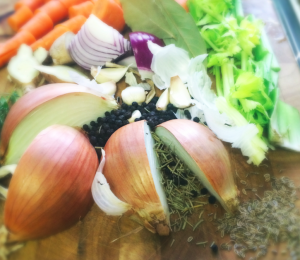Israel. I will soon travel there, and may never return. In addition to it being such a sacred region of our beautiful planet, they have hummus and lots of it. They also have tabbouleh, tahini, olives, and olive oil––five of my favorite things to eat. The Israelis goodies and their generous use of parsley and lemon have wooed me for many years.
And then there are the pickles.
These briny veggie gems of all kinds seal the deal on my Middle Eastern Mediterranean food affair.
Most of the time, you can find a variety of house made pickles in my refrigerator. I eat them straight from the jar, toss them in salads, and pair with all the aforementioned Mediterranean delights in mezze platters, which I frequently enjoy.
Since I have a lot going on, time is of the essence when making pickles. I also happen to LOVE the taste of vinegar, and so rather than waiting for lacto-fermentation (pickles preserved with salt––a deeply nourishing method), I often do quick vinegar brine pickling. If you are not a fan of vinegar, the following recipe is probably not for you. In the not so distant future, I’ll be blogging about lacto-fermentation, and that post might be more fitting. If you are into vinegar, please proceed.
I’ve outlined the following steps and considerations to support a more efficient and pleasurable experience.
1. Pickles do not have to be relegated to cucumber slices. Be creative and experiment with green beans, asparagus, radishes, turnips, okra, cauliflower, carrots, and beets (another recipe for another time as the brine for beets tends to be a tad sweeter.)
2. Select your jars. I like to use 16-ounce Mason or Ball jars with canning lids. Consider making four to six jars for yourself in a single batch. Double or triple your recipe if you plan to give some away. They make great gifts!
3. Make enough, but not too much for you and others to consume within sixty days. I eat a lot of these babies and so go through four jars myself in about a month and a half. Since these are not lacto-fermented or preserved pickles, their freshness term is not as long.
4. On pickling day, sanitize your jars in the dishwasher while you prep your veggies. If you do not have a dishwasher, bring a large pot of water to a roaring boil. One or two at a time, dunk lids, jars, and sealing rings into the water, and boil for one minute. Use tongs to remove, and set them on your counter to air dry. Do this step prior to prepping, so that when your veggies are trimmed and pretty, you can divide them between the jars right away.
5. Make your pickling spice (recipe below) in advance. Quadruple the recipe to have a big batch on hand at all times…you never know when you’ll get a hankering for pickles!
Makes: approx. 6 (16-ounce) jars of pickles
Time: 1 hour + 3 days
Ingredients:
4 cups apple cider vinegar
6 tablespoons kosher salt
3 tablespoons coconut palm sugar
4 cups water
3-4 medium carrots, cut into (4-inch x 1/4-inch sticks), scrubbed
1 cup cauliflower florets
1 medium cucumber*, sliced into 1/4-inch discs, do not peel
6-8 pieces of okra, tops trimmed off
10-12 green beans, stems cut off
1/2 cup pink turnip, scrubbed, and cut into (2-inch x 1/4-inch) sticks
10 asparagus stems with tops in tact, about 4-inches in length
1/2 large white onion, cut into (1-inch x 1-inch) pieces
1-2 medium garlic cloves, halved per jar
1 jalapeño, sliced into 1/8-inch discs
1-2 dried guajillo, ancho, or red serrano chilies (depending on how spicy you want them to be.)
1/2 cup fresh dill (more or less depending on how dilly you want them to be.)
1-2 bay leaves for each jar (I like to use two each)
*You’ll want to salt the cucumbers generously, and place them in a strainer over a bowl or sink. The salt will extract excess liquid. After about an hour, rinse them well with cold water, and pat dry.
Spice Blend:
This spice blend recipe is not to be considered exact. Depending on the savory flavors you most enjoy, feel free to improvise using more or less of the following.
1 tablespoon coriander seed
1 tablespoon mustard seed
2 teaspoons caraway seed
1 tablespoon cumin seed
1 tablespoon fennel seed
2 teaspoons dried dill weed
2 teaspoons dill seed
2 teaspoons celery seed
1 tablespoon black peppercorns
Preparation:
1. With your jars already sanitized, veggies prepped, and spices blended, you are ready to make your vinegar brine.
2. In a medium saucepan, combine apple cider vinegar, kosher salt, coconut palm sugar, and water. Bring to a boil, and heat until sugar and salt have dissolved completely.
3. While the brine is coming to a boil, divide veggies, onion, garlic cloves, jalapeño, dried chilies, fresh dill, and bay leaves between jars. Pack the vegetables tightly. Feel free to co-mingle, or do one jar per variety. Add approximately one tablespoon of spice blend to each jar.
4. Carefully pour boiling brine into each jar (you might want to use a funnel to keep from getting burned with hot liquid,) and fill to the very top. Quickly seal each jar.
5. Cool completely to room temperature, and then transfer to your refrigerator. Let them rest for three days before opening to ensure ample infusion of flavor.
Enjoy!













